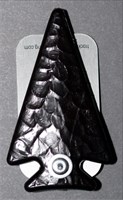This is not collectible.

This travel bug is one of several commemorating the major Indian tribes native to the land of what is now Texas from historic times (in general from the 18th century). The term tribe applies to peoples who spoke the same language and and shared the same customs and rituals. There are many other tribes and lesser-known bands occupying Texas than are acknowledged here. Some of these were never large enough to be considered a major tribe, others ceased to exist before the 1700s (assimilation and disease), some these were driven into the region by European-American expanansion (Cherokee, Kickapoo, Tigua, Alabama, others), and finally some could not be classified because they were never seen by keen observers while their language and ways were still intact. The Cohuiltecans of south Texas fit all these criteria. It would be a mistake to assume that these tribes are insignificant in the history of Texas. Below is a brief narrative of the presence of one major tribe from historic times. Much of the information is from the online Texas Almanac.
The Kiowas, according to their traditions, were hunters living at the sources of the Yellowstone and Missouri rivers in present Montana. They hunted with bow and arrow. The dog was their only domesticated animal, drawing the travois with poles attached to harness. The Flatheads were neighbors and north and west were several Athabascan tribes such as their friends, the Sarsis. According to legend a quarrel divided the tribe over hunting spoils-the udders of a doe. The winners of that delicacy moved southeastward with the Kiowa Apaches to live with friends, the Crows. Those left behind were never heard of again.
The Crows taught them to ride horses and hunt buffalo-animals they had never seen before. There was some intermarriage with the Crows as there was with the Sarsis, as they still visited the Sarsis. Dohäsan, one of the greatest of Kiowa chiefs, had a Crow ancestor. The earliest written mention of the Kiowas and their long affiliated tribe, the Kiowa Apaches, was in 1682 by René Robert Cavelier, Sieur de La Salle, who heard of them from a captive Pani slave boy at Fort St. Louis. The Lewis and Clark expedition in 1804 heard of them in the Yellowstone region but did not meet them.
Having acquired the Plains Culture by learning to ride and hunt on horseback, they moved southward for more horses and gained horses, slaves, and guns from the Spanish. The Kiowas evolved into completely nomadic lifeways of predation, pillage, and warfare, until they became one of the most feared and hated of the Plains tribes. Constantly they kept the greatest numbers of horses of all the Plains Indians.
About 1790 the Kiowas made a lasting peace with the Comanches and with them traded horses and captives east by way of the Wichitas and Taovayas to the French and English for guns, ammunition, and metal for points and vermilion for face paint. In 1840, under the sponsorship of William Bent, the Kiowas, Kiowa Apaches, and Comanches joined with the Southern Cheyennes and Arapahos at Bent's Fort on the Arkansas in a peace never broken. Bent's wife was a Cheyenne, and he wanted the Cheyennes and Kiowas to trade there in peace. The five tribes in union made a formidable barrier athwart the Arkansas to passage across the southern plains. The government sent the First Dragoons to protect wagontrains on the Santa Fe Trail. Later the Second Dragoons and the Mounted Rifles tried to protect the southwest and Texas from Indian incursions. In the 1850s the Second United State Cavalry sought to stem the attacks on the frontiers of the southwest and Texas by the five tribes but with little success.
The Kiowas were noted for their depredations in Old Mexico and Texas. One such event in 1871 became known across the nation as the Warren Wagontrain Raid. The ambush was led by Satanta, Big Tree, Satank, and Eagle Heart. The braves attacked at train of 10 mule-drawn wagons filled with army corn and fodder. On spotting the danger, the corn train shifted into a ring formation, and all the mules were put into the center of the ring. However, the Kiowa quickly overwhelmed this convoy, killing and mutilating seven of the wagoneer's bodies. The warriors lost three of their own, but left with 41 mules heavily laden with supplies. Five wagoneers managed to escape, one of which was Thomas Brazeale who reached Fort Richardson on foot, some 20 miles away.
Two Kiowas, Satanta and Big Tree were tried for murder, the first time that Indians were held accountable for their raids. Satanta and Big Tree were tried in a white man’s court and condemned to death; the sentence was later commuted to life imprisonment. Two years later they were paroled. When Satanta joined in the second battle of Adobe Walls in 1874 against the buffalo hunters, he was sent back to prison for violating parole. In 1878 he jumped from a second story window to his death.
The Wagontrain massacre was brought headlines because General William T. Sherman was inspecting the area at the time. The military response focused on destroying the Kiowa horses while buffalo hide hunters were destroying the buffalos, their main food supply. The last hostiles were brought in to Fort Sill, Oklahoma, in June of 1875. The Kiowas embraced the transition to white culture better than most Native American tribes. For many it was done in one generation. The 1989 United States census reported 4,800 Kiowas.